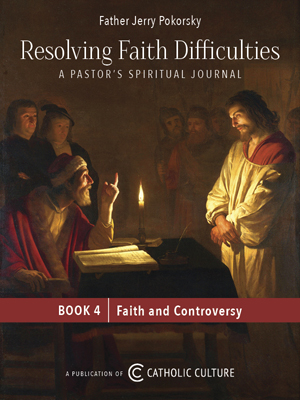How Mary crushes the head of Satan
By Fr. Jerry Pokorsky ( bio - articles - email ) | Mar 06, 2020
The familiar statue of the Immaculate Heart of Mary, with her foot forcing the innards out of the serpent, is grotesquely satisfying. We delight in the final victory over the powers of darkness. But is devotion to Mary as a dragon-slayer a mere pious distraction based on tenuous Scriptural citations? In our fight against evil, instead of invoking Mary’s prayers, should we put more faith in bureaucratic “policies, procedures, and protocols” ensuring that [fill in the blank] never happens again?
The Devil’s successful temptation of Adam and Eve into Original Sin brought suffering and death into the world. After describing the ensuing afflictions, God promises a Redeemer: “I will put enmity between you and the woman, and between your seed and her seed; he shall bruise your head, and you shall bruise his heel.” (Gen. 3:15). The Woman kills the serpent through her seed.
In Luke’s Gospel, there is a significant reinforcement of Mary’s exalted role as the maternal “Defender Against Demons.” During her visit with Elizabeth her cousin, Mary responds with a spontaneous prayer rooted in her familiarity with Scriptures. Mary’s Magnificat (Luke 1:46-55) not only anticipates the Devil’s temptations of Jesus thirty years later but prophesies victory over evil in “every generation.”
At the beginning of his public ministry, Jesus is led by the Spirit into the wilderness (cf. Mt. 4:1-11). He is hungry after forty days and forty nights of fasting. The Devil entices Jesus with a threefold temptation.
The flesh: “If you are the Son of God, command these stones to become loaves of bread.” But Jesus answers, “It is written, ‘Man shall not live by bread alone, but by every word that proceeds from the mouth of God.’” Without God’s word, “bread alone”—the materialism of “the flesh”—opposes God.
The world: The devil takes Jesus to Jerusalem, sets Him on the pinnacle of the temple, and says, “If you are the Son of God, throw yourself down; for it is written, ‘He will give his angels charge of you,’ and ‘On their hands they will bear you up, lest you strike your foot against a stone.’” But Jesus responds, “Again it is written, ‘You shall not tempt the Lord your God.’” Without God, the world and all its power are but diabolical temptations.
The Devil: Finally the Devil takes Jesus to a very high mountain and shows Him the kingdoms of the world and their glory. The Devil goes for broke and says to Him: “All these I will give you, if you will fall down and worship me.” The response of Jesus is definitive: “Begone, Satan! for it is written, ‘You shall worship the Lord your God and him only shall you serve.’” Later in the Gospel, Jesus warns us: “For what does it profit a man, to gain the whole world and lose his soul?” (Mark 8:36)
Mary similarly refutes the Devil’s threefold temptation point-by-point, but she does so in prophesy while carrying Jesus as a babe in her womb. In her Magnificat (as taken from the Breviary), Mary acknowledges that she is the blessed handmaiden for all generations to come, the “New Eve.”
My soul [magnifies] the greatness of the Lord,
My spirit rejoices in God my Savior
For he has looked with favor on his lowly servant.
From this day all generations will call me blessed:
the Almighty has done great things for me
and holy is his Name.
He has mercy on those who fear him
in every generation.
The Devil: Just as Jesus exorcises the Devil, Mary prophesies her Son’s victory over diabolical pride, the cause of the Fall:
He has shown strength with his arm,
he has scattered the proud in their conceit.
The World: Just as Jesus says, “You shall not tempt the Lord your God” with worldly allures, Mary prophesies God’s strength:
He has cast down the mighty from their thrones,
And has lifted up the lowly.
The Flesh: Just as Jesus affirms that “man shall not live by bread alone, but by every word that proceeds from the mouth of God,” Mary prophesies the emptiness of riches without God and His word:
He has filled the hungry with good things,
And the rich he has sent away empty.
He has come to the help of his servant Israel
For he has remembered his promise of mercy,
The promise he made to our fathers,
to Abraham and his children forever.
Hence, Mary’s prayer with the child Jesus in her womb prophesies the fulfillment of the promise God made in Genesis 3:15.
We face the same temptations that Jesus endured for our sake: “For we have not a high priest who is unable to sympathize with our weaknesses, but one who in every respect has been tempted as we are, yet without sinning.” (Heb. 4:15)
The Magnificat, recited every evening in the Divine Office, continues to crush the head of the Devil. It should be a cornerstone of our daily spiritual policies, procedures, and protocols.
All comments are moderated. To lighten our editing burden, only current donors are allowed to Sound Off. If you are a current donor, log in to see the comment form; otherwise please support our work, and Sound Off!
-
Posted by: phil L -
Mar. 15, 2020 3:29 PM ET USA
Father Pokorsky replies: Acknowledged. But Cory misses a carefully constructed sentence that takes the error into account but does not go into the weeds of exegesis: God promises a Redeemer: “I will put enmity between you and the woman, and between your seed and her seed; he shall bruise your head, and you shall bruise his heel.” (Gen. 3:15). The Woman kills the serpent through her seed.
-
Posted by: Cory -
Mar. 11, 2020 5:01 PM ET USA
Correction. Our Lord is the one who crushed the head of the serpent and this is clear in Gen 3:15. The World image of Mary with the serpent beneath her feet is due to a mistranslation in the Vulgate.








